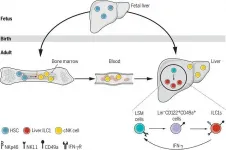(Press-News.org) Risks of SARS-CoV-2 coronavirus infection for long-stay nursing home residents were mainly dependent on factors in their nursing homes and surrounding communities, according to a large study led by a researcher at the Johns Hopkins Bloomberg School of Public Health.
By contrast, the study found that the risks of being hospitalized with, and of dying from, COVID-19, depended more on patient-specific characteristics such as age and body mass index--although the mix of factors linked to hospitalization was distinct from the mix of factors linked to mortality.
The study, which appears online March 31 in JAMA Network Open, detailed COVID-19 risk factors among more than 480,000 long-stay nursing home residents in the United States between April 1 and September 30, 2020. The study is thought to be the first national study of long-term nursing home residents in the U.S.
"Our findings suggest that the dynamics of the pandemic work differently in a nursing home setting than they do in the wider community," says study lead author Hemalkumar Mehta, PhD, assistant professor in the Department of Epidemiology at the Bloomberg School. "The findings should help community leaders and nursing home administrators in devising better protections for nursing home residents during the remainder of the COVID-19 pandemic and in future pandemics."
Among the roughly 30 million recorded cases of COVID-19 in the U.S. since the start of the pandemic, there have been more than 500,000 deaths. Of those U.S. deaths, about one-third have been in nursing homes. These facilities have been especially vulnerable to COVID-19 due to their concentrations of frail, elderly residents.
Even so, the COVID-19 case, hospitalization, and mortality rates have varied greatly among nursing homes.
For their study, the researchers used Medicare data to identify a cohort of 482,323 long-stay nursing home residents, aged 65 and up, who had not yet been diagnosed with COVID-19 as of April 1 of last year. The cohort included residents at 15,038 nursing homes across the U.S.
A total of 137,119 residents (28.4 percent) were diagnosed with SARS-CoV-2 infection during the period April 1 through September 30. The researchers found that the risk of infection was dependent mainly on which nursing home the resident lived in, and in which county, rather than patient-specific factors.
When accounting for the influence of local factors, the large nominal differences in infection rates between whites and Blacks, whites and Asians, and whites and Latinos went virtually to zero.
Among the personal characteristics examined, only body mass index, a gauge of thinness or obesity, appeared to be important in determining infection risk: Having a BMI greater than 45 ("morbidly obese") was associated with 19 percent more infection risk than having a BMI in the normal range of 18.5 to 25.
The risk of hospitalization varied more with personal factors. A BMI of 40-45 was associated with 24 percent greater risk, and a BMI over 45 with 40 percent greater risk, compared to a BMI in the normal range.
Frailty and poor health appeared to be factors too. Residents with severe functional impairment were 15 percent likelier to be hospitalized when they got COVID-19; and those who had to use a catheter were 21 percent likelier.
Ethnicity/race was a big factor in hospitalization risk, even when adjusting for nursing home facility and geography. Asian nursing home residents, for example, were 46 percent more likely than whites to be hospitalized when diagnosed with COVID-19.
Somewhat surprisingly--and contrary to the results of prior studies outside nursing homes-- factors most associated with hospitalization risk appeared to have a lesser role in mortality risk after controlling for differences among nursing homes. Asians were more likely than whites to die when they got COVID-19, but only 19 percent more likely. Moreover, Blacks and Hispanics had no significant difference in mortality risk compared to whites.
Again surprisingly, BMI was not a significant risk factor for mortality--except for those with a BMI below the normal range, who had a 19 percent greater risk of dying when infected with COVID-19.
Older age was the largest apparent mortality risk factor. For example, being over 90 was associated with 155 percent greater risk, compared to being 65-70, and even being 81-85 brought a 76 percent increase in mortality risk compared to the youngest age bracket of 65-70 years.
Cognitive impairment was another mortality risk factor--severely impaired residents were 79 percent more likely to die of COVID-19 than those with no cognitive impairment. Similarly, severe functional impairment was associated with a 94 percent greater chance of mortality.
Male residents were 57 percent likelier than females to die when they had COVID-19.
On the whole, according to the researchers, the results suggest that hospitalization and mortality risks, which normally go together for people living at home, were somewhat disconnected in the nursing home setting, at least under the unusual circumstances of the COVID-19 pandemic.
"This may represent resident or family preference to avoid hospitalization, triaging decisions when local hospitals were full, or other factors yet to be determined," Mehta says.
One bright spot in the data, the researchers note, is that the mortality rate dropped dramatically during the study period, from 29.9 percent in April to 15.8 percent in September.
INFORMATION:
"Risk Factors Associated with SARS-CoV-2 Infections, Hospitalization, and Mortality Among US Nursing Home Residents" was co-authored by Hemalkumar Mehta, Shuang Li, and James Goodwin.
The work was supported in part by grants from the National Institutes of Health (K05-CA134923, UL1TR001439) and the Claude D. Pepper Older Americans Independence Center.
Roughly five years ago, Institute Head Prof. Dr. William (Bill) Martin and his team introduced the last universal common ancestor of all living organisms and named it "LUCA". It lived approximately 3.8 billion years ago in hot deep sea hydrothermal vents.
Now the evolutionary biologists in Duesseldorf have described a further ancient cell named "LBCA" ("Last Bacterial Common Ancestor"). It is the ancestor of today's largest domain of all living organisms: Bacteria. In Communications Biology, they report on their new research approaches which led to the successful prediction ...
Every day, people are exposed to microplastics from food, water, beverages and air. But it's unclear just how many of these particles accumulate in the human body, and whether they pose health risks. Now, researchers reporting in ACS' Environmental Science & Technology have developed a lifetime microplastic exposure model that accounts for variable levels from different sources and in different populations. The new model indicates a lower average mass of microplastic accumulation than previous estimates.
Microplastics, which are tiny pieces of plastic ranging in size from 1 μm to 5 mm (about the ...
In Brazil, researchers are puzzling over socioeconomic and environmental indicators that do not add up. They are concerned with what they call the São Paulo Macrometropolitan Area, a mega-region comprising five metropolitan areas in the state of São Paulo with a total of 180 municipalities, some of which provide ecosystem services while others receive them. The problem is that the former, which provide the others with water, food and power generation inputs, suffer from steep inequities in terms of defective human development and lack of social inclusion.
"Urban centers have always been ...
Glass, rubber and plastics all belong to a class of matter called amorphous solids. And in spite of how common they are in our everyday lives, amorphous solids have long posed a challenge to scientists.
Since the 1910s, scientists have been able to map in 3D the atomic structures of crystals, the other major class of solids, which has led to myriad advances in physics, chemistry, biology, materials science, geology, nanoscience, drug discovery and more. But because amorphous solids aren't assembled in rigid, repetitive atomic structures like crystals are, they have defied researchers' ability to determine their atomic structure with the same level of precision.
Until now, that is. ...
Sugar practically screams from the shelves of your grocery store, especially those products marketed to kids.
Children are the highest consumers of added sugar, even as high-sugar diets have been linked to health effects like obesity and heart disease and even impaired memory function.
However, less is known about how high sugar consumption during childhood affects the development of the brain, specifically a region known to be critically important for learning and memory called the hippocampus.
New research led by a University of Georgia faculty member in collaboration with a University ...
LAWRENCE, KANSAS -- The phrase "to see red" means to become angry. But for investors, seeing red takes on a whole different meaning.
William BazleyThat's the premise behind a new article by William Bazley, assistant professor of finance at the University of Kansas.
"Visual Finance: The Pervasive Effects of Red on Investor Behavior" reveals that using the color red to represent financial data influences individuals' risk preferences, expectations of future stock returns and trading decisions. The effects are not present in people who are colorblind, and they're muted in China, where red represents prosperity. Other colors do not generate the same outcomes.
The ...
As demand for low-carbon electricity rises around the world, nuclear power offers a promising solution. But how many countries are good candidates for nuclear energy development?
A new study in the journal Risk Analysis suggests that countries representing more than 80 percent of potential growth in low-carbon electricity demand--in Asia, the Middle East, and North Africa--may lack the economic or institutional quality to deploy nuclear power to meet their energy needs. The authors suggest that if nuclear power is to safely expand its role in mitigating climate change, countries need to radically improve their ability to manage the technology.
"Efforts to enhance institutional quality in these countries must be redoubled and could well be one of the ...
Taking progestogens - steroid hormones - during pregnancy could reduce the risk of preterm birth in high-risk single baby pregnancies, research has shown.
Although these compounds have been in use for some time, results of individual clinical trials investigating their effectiveness in preventing preterm birth have been conflicting, and so further evaluation of the research evidence was needed.
University of York researchers led the Evaluating Progestogens for Prevention of Preterm Birth International Collaborative (EPPPIC) project, a systematic review which brought together and re-analysed datasets from 31 clinical trials of progestogens, including more than 11,000 women and 16,000 babies ...
Microbial life already had the necessary conditions to exist on our planet 3.5 billion years ago. This was the conclusion reached by a research team after studying microscopic fluid inclusions in barium sulfate (barite) from the Dresser Mine in Marble Bar, Australia. In their publication "Ingredients for microbial life preserved in 3.5-billion-year-old fluid inclusions," the researchers suggest that organic carbon compounds which could serve as nutrients for microbial life already existed at this time. The study by first author Helge Mißbach (University of Göttingen, Germany) was published in the journal ...
Researchers from the University of Science and Technology of China (USTC) of the Chinese Academy of Science (CAS), teamed up with scientists from Aix Marseille University, discovered that hematopoietic progenitors possessed the differentiation potential to type 1 innate lymphoid cells (ILC1s) in adult liver, and dissected the regulation mechanisms of such cell differentiation, revealing the pathways that lead to the development of tissue-resident lymphocytes. This study was published in Science.
Hematopoiesis occurs at different sites following the development of human body. After birth, the bone marrow (BM) has long been known to be the main hematopoietic organ ...




